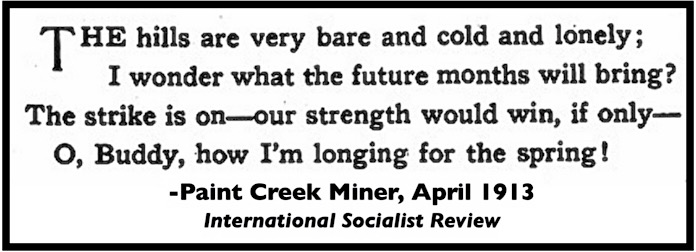 —————
—————
Hellraisers Journal – Thursday April 2, 1914
“The Kanawha Striker” by Paint Creek Miner & Drawing by Charles Winter
From The Masses of April 1914:
 —————
—————
Hellraisers Journal – Thursday April 2, 1914
“The Kanawha Striker” by Paint Creek Miner & Drawing by Charles Winter
From The Masses of April 1914:
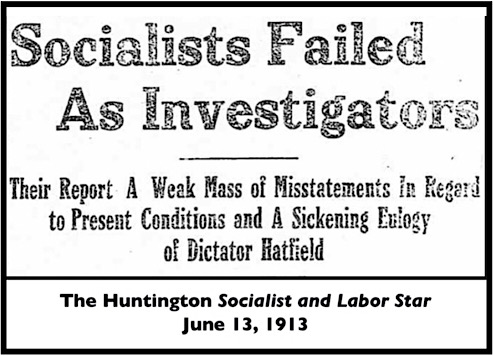 —————
—————
Hellraisers Journal – Sunday August 10, 1913
W. H. Thompson Opines on Strike Settlements in West Virginia
From the International Socialist Review of August 1913:
Strike “Settlements” in West Virginia
By W. H. Thompson
[Editor of Huntington Socialist and Labor Star]
IN an article in the July REVIEW I detailed at some length the manner in which the odious Hatfield-Haggerty “settlement” of the Kanawha strike was ”put over” on the workers by the coercion of Hatfield and the trickery of the United Mine Workers’ officials. I have received numerous letters from persons prominent in the Socialist party and in the mine workers organization severely criticizing my statements and intimating in very forceful language that I knew not of what I wrote. In justice to these writers I will say that in every instance they were citizens of other states, and, with few exceptions, have never been in West Virginia.
As proof of the accuracy of my statements made in that article I wish to chronicle the happenings in the affected zone since it was written.
The coal miners of Paint Creek and Cabin Creek have unanimously repudiated the agreement entered into for them by Hatfield-Haggerty & Co., and are again on strike. Furthermore, they have compelled Haggerty and the other compromising officials of the U. M. W. of A. to retreat from their former position as absolute dictators, and to grant to their strike a tardy official recognition.
These leaders were placed in a rather peculiar position in thus being compelled to endorse a strike against the agreement they themselves had forced upon the miners, and to “save their face” they loudly proclaimed that the coal barons had violated the provisions of the holy Hatfield Proposition and thus justified the strike.
This brought forth a hot reply from the coal operators’ association, which proved another assertion of mine, to the effect that there was nothing in the Hatfield proposition demanding any changes in their attitude toward the miners. They said in part:
“There was never any promise or agreement on our part to take back strikers or to surrender our rights of hiring or discharging men as we saw fit. We entered into no agreement with the United Mine Workers. We promised the Governor that we would do certain things toward ending the violence on Paint and Cabin Creeks. We have kept this promise in the strictest good faith and there is no foundation for any statement to the contrary.”
In regard to this Dean Haggerty made a public statement in which he said:
“Owing to my absence from the city on important business I have as yet been unable to prepare a detailed reply to the statement of the operators’ association. But I shall do so shortly and show that the Governor’s proposition has been grossly violated.”
The Dean made this promise of a “detailed statement” on June 22, but as yet he has failed to make the statement or show wherein the operators had grossly violated the Hatfield proposition. No one knows better than Haggerty that there was nothing in the proposition that the operators would have any call to violate.
In the meantime the strike in the Paint and Cabin Creek district grows in intensity, and conditions are rapidly approaching the guerilla warfare stage. The criminal mine guards are again in evidence and are using the same old tactics to stir up violence. Already one battle has taken place. This called forth from Governor Hatfield a long open letter to Sheriff Bonner Hill, he, of “armored train” fame, in which he declared that if the civil authorities could not preserve peace in the strike zone they should resign. He also intimated that he might summarily remove such officials as were lax in their duties. When it is remembered that Hatfield tried to “preserve peace” up there with the entire state army and failed, and that he has not as yet resigned his office, his advice appears a little premature, to say the least.
The New River “Settlement”
It would seem to the casual observer that Haggerty & Co. would have learned a few things from their failure to “put over” the now infamous Kanawha Settlement, but, alas, they belong to that specie of old line craft union leaders who never learn and never change. At the very time the Kanawha miners were repudiating the agreement entered into for them by these gentlemen, Haggerty, Hatfield and the New River operators were concocting another settlement prescription to be used upon the restless and dissatisfied New River miners.
This proposition, which was agreed upon by the gentlemen who drew it up, was meant for no other purpose than to chloroform the growing spirit of unrest among the miners in this field and to keep them producing coal to fill the contracts of the Kanawha operators whose mines are closed by the strike there.
The New River agreement is a replica of the infamous Hatfield proposition to settle the Kanawha strike. The workers realize absolutely nothing from its acceptance. And to effectually prevent the miners from ever gaining any concessions under it the following clause is appended:
“Sixth-All matters of dispute, with reference to the above proposition, as between the individual operator and miners in each mine in the New River and Virginia districts, to be referred to a commission of four, two of whom are to be selected by the operators and two by the miners neither of whom are to be interested in mines or mining, either directly or indirectly, and that where a controversy arises, both operator and miner may appear before the said board, and the board, after hearing the evidence from both sides, shall render a decision, and any decision signed by any three of said board shall be final and binding on both operators and miners. Should said board be unable to reach a majority decision, then they shall take the matter to the governor of the state, who shall act as umpire and whose decision shall be final and binding on both operators and miners, and there shall be no appeal therefrom.”
See any chance for the real interested parties, the coal miners, having any say in matters of dispute?
Bear in mind, please, that this agreement, contract, settlement or whatever it is, was never submitted to the miners for their acceptance or rejection. It was accepted for them by the wise Christian leaders whom God and the United Mine Workers of America sent here to act for them. And their interests are further protected Umpire Hatfield from whose decision no appeal can be taken.
 —————
—————
Hellraisers Journal – Friday July 4, 1913
West Virginia Coal Miners’ Victory Turned into “Settlement”-Part I
From the International Socialist Review of July 1913:
[Part I of III]
To those who have been actively engaged in the epochal struggle of the coal miners in this state the present status of affairs is anything but optimistic.
The miners after having put up a fight that won the admiration of the entire working class the country over, have lost their strike and are being driven sullenly back to the Coal Trust’s subterrean hells to produce coal for their brutal masters under the same conditions which have prevailed in the West Virginia coal fields for years, and against which these miners revolted over a year ago.
It is not my intention to give a recapitulation of the stirring events of the Paint Creek strike, but rather a hurried sketch of the manner in which a well earned victory was turned into an empty and meaningless settlement, by a combination of forces against which the miners found themselves helpless.
The coal diggers of the Kanawha valley have proven themselves to be as brave and loyal a set of men as ever established a picket line. They have stoically and uncomplainingly borne the barbaric and inhuman treatment to which they were subjected by the Coal Trust and its political creature-the state government. They had by the sheer force of solidarity, and in spite of the weakness of the antiquated tactics taught them by the officials of the United Mine Workers of America, brought the coal barons to their knees. The state government, too, had exhausted its ingenuity and failed to break the strike. There remained but one hope for the masters of the mines. That was to enlist in their behalf the United Mine Workers of America.
When in the course of these remarks I use the expression ”U. M. W. of A.,” it is meant to apply, not to the men who actually dig coal, but rather to the official oligarchy known as the National Executive Board, members of which were handling the strike in this state.
Overtures were evidently made to these representatives by Governor H. D. Hatfield, acting for the coal autocracy. An agreement was reached, and the three organizations, viz: the Coal Trust, the State government and the U. M. W. of A., acting co-operatively, played the last card which won for the mine owners that which they would have never gained unaided by their last ally.
Everything being “understood” and agreed upon, Hatfield made public what he termed a “proposal for the settlement of the Kanawha strike.”
The proposal made no mention of the three cardinal demands of the miners the elimination of the hated guard system, the right to belong to a union and the payment of the “Kanawha Scale” of wages. In fact it offered absolutely nothing in the way of concessions from the operators-merely insisting-when sheared of its luxuriant verbosity-that the miners return to work under the same conditions that existed before they struck-if the mine owners would let them.
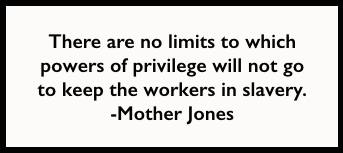 —————
—————
Hellraisers Journal – Thursday June 26, 1913
Charleston, West Virginia – Testimony Before Senate Committee Reveals Peonage
From The Wheeling Majority of June 19, 1913:
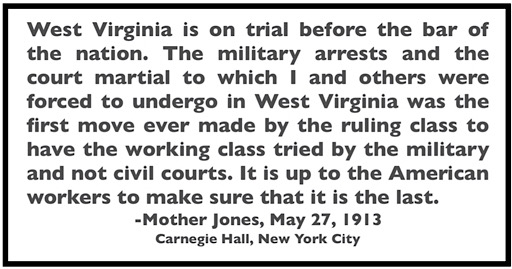 —————
—————
Hellraisers Journal – Sunday June 1, 1913
Charleston, West Virginia – Socialists Committee Investigates Industrial Conditions
From the Huntington Socialist and Labor Star of May 30, 1913:
From The Coming Nation of May 24, 1913:
 —————
—————
Hellraisers Journal – Saturday May 17, 1913
Mother Jones Writes from West Virginia Bastile to Tom Hickey, Editor of The Rebel
From the Oklahoma City Social Democrat of May 14, 1913:
 —————
—————
Hellraisers Journal – Tuesday May 6, 1913
John W. Brown on West Virginia Despotism: The Attack on Holly Grove
From The Coming Nation of May 3, 1913:
[Part I of III]
NOW that hostilities between the hired assassins of the coal barons and the coal miners have ceased, the new governor, H. D. Hatfield, inaugurated, and well on his way with “his policy,” and all the undesirable citizens incarcerated and held incommunicado, and “peace reigns throughout the war zone,” society in general may find time to consider for a few brief moments just where we are at, and, incidentally, decide whether or not West Virginia is still a part of the United States, or whether she has not put herself clear outside the organic law of the nation.
Owing to the fact that all the miners and their sympathizers who were arrested with them have been kept practically incommunicado, while the most strict censorship has been enforced so far as the facts are concerned, I make haste at this the first opportunity we have had to present the miners’ side of the conflict. I do not wish to deal here with the long-drawn-out conflict which has been going on now between the miners and the operators for the past year. Of this the general public is more or less conversant.
It is with recent developments and the new administration that we have to deal in this article, and these date from February 7th, 1913.
Since the strike broke out a year ago, the dispossessed miners have been living in tents at Holly Grove, which is situated about one mile up the Paint Creek branch of the Chesapeake and Ohio Railroad. This village of canvas tents has attracted considerable attention owing to the fact that it was so near the junction where the men were ever on the watch for scabs going in, and always ready to help out of the mining regions those who were taken there under false representations.
It became apparent to the operators very early in the struggle that so long as Holly Grove remained a haven of rest for the homeless miners and escaping peons they could never secure a sufficient force to operate their mines successfully, and on more than one occasion they set out through the aid of their hired assassins, the Baldwin-Feltz detectives, to wipe it off the map, but in anything like an even brake the miners put them to route.
The Baldwin guards have a special train at their disposal which became known throughout the region as the “Bull Moose.” Driven desperate by the passive mood of the miners, and unable to break down their solidarity, the Chesapeake and Ohio Railroad, at the instigation of the coal barons, had this “Bull Moose” armored with one-half inch boiler plate with suitable port holes on each side.
On the night of February 7th [Friday], about 10 p. m., this “Bull Moose” stole into Holly Grove with all lights out and when abreast of the dwelling of the miners opened fire. One of the strikers, whose tent was so near the track that the shots ranged over it, in describing the shooting said that when the fire opened it sounded like “thirty-thirty” rifles and pistols, but when the train got abreast of the village proper, they turned loose the machine guns.
Several people were hit with bullets, the most serious being Mrs. John Hall, who was shot through both legs while she sat by her own fire, and Sesco Eastep [Francis/Francesco/Cesco, Estep] who was killed with his babe in his arms.
At first it was thought that the shooting was done on the initiative of the Baldwin guards, but the following day brought forth the fact that Bonner Hill, the republican sheriff, and several operators as well as Baldwin guards, were on the train, and that the orders to shoot were given by the man who only a few days previous held up his hand and swore, “so help him God,” that he would use whatever power vested in him as sheriff of Kanawah County to keep the peace.
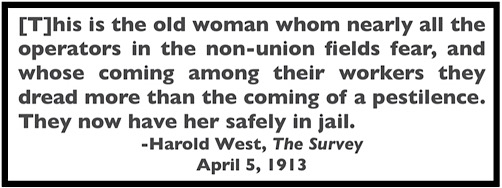 —————
—————
Hellraisers Journal – Thursday April 10, 1913
Mother Jones and the Civil War in the Kanawha County Coalfields
From The Survey of April 5, 1913:
Mother Jones
[-by Harold West]
The developments of the winter have been under the regime of a third governor, who came to the state house at season when part of the commonwealth was under martial law. In March came the trials of a number of the strikers their sympathizers-approximately fifty-by a military court on charges of inciting to riot, conspiracy to murder and conspiracy to destroy property. Among those in prison is Mother Jones, the “Stormy Petrel of Labor” who is always present in big labor disturbances, especially those of the miners and the railroad men. She has given the best part of her life to the cause of laboring men and they adore he.
This old woman, more than 80 years of age, was in the mines when I went there and I got to know her well. She passed the word along to the men that I was “all right” and reticent as they are to strangers, they told me their side of the case without reservation.
I have been with Mother Jones when she was compelled “to walk the creek,” having been forbidden to go upon the footpaths that happened to be upon the property of the companies and denied even the privilege of walking along the railroad track although hundreds of miners and others were walking on it at the time. She was compelled to keep to the county road although it was in the bed of the creek and the water was over her ankles. I protested to the chief of the guards saying that no matter what her attitude might be, no matter how much she might be hated, that she was an old woman and common humanity would dictate that she be not ill treated. I was told that she was an old “she-devil” and that she would receive no “courtesies” there, that she was responsible for all the trouble that had occurred and that she would receive no consideration from the companies.
I was with her when she was denied “the privilege” of going up the footway to the house of one of the miners in order to get a cup of tea. It was then afternoon, she had walked several miles and was faint, having had nothing to eat since an early breakfast. But that did not shut her mouth. She made the speech she had arranged to make to the men who had gathered to hear her although they had to line up on each side of the roadway to avoid “obstructing the highway,” a highway that was almost impassable to wheeled vehicle and which there was no travel. And in that speech she counseled moderation, told the men to keep strictly within the law and to protect the company’s property instead of doing anything to injure it.
I had several long talks with her. When she speaks to the miners she talks in their own vernacular and occasionally swears. She was a normal school teacher in her early days, and in her talks with me in the home of one of her friends in the “free town” of Eskdale, she used the language of the cultured woman. And this is the old woman whom nearly all the operators in the non-union fields fear, and whose coming among their workers they dread more than the coming of a pestilence. They now have her safely in jail.
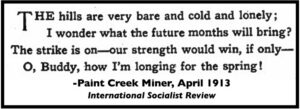 —————
—————
Hellraisers Journal – Wednesday April 9, 1913
“Civil War in the West Virginia Coal Mines” by Harold E. West
From The Survey of April 5, 1913:
FOR nearly a year a state of turmoil amounting in practical effects to a civil war has existed in the coal fields of West Virginia. The situation centers in the Kanawha Valley, hardly more than twenty miles from Charleston, the capital of the state.
The military power of the state has been used with only temporary effect; martial law has been declared and continues in force; the governor of the state has been defied and denounced from the state house steps and within his hearing; men and women have been thrown into prison and are still there for espousing the cause of the miners, and the grim hillsides of the canons in which the mines are situated are dotted with the graves of men who have been arrayed against one another in this conflict between capital and labor…..
[U. S. Secretary of Labor William B.] Wilson charged that a condition of peonage existed in the mines and that men were held there by force and compelled to work against their will. The coal operators denied this vehemently, at the same time fighting bitterly a federal inquiry. Evidence I was able to gather on a trip of investigation to the mines convinced me that a form of peonage does, or did exist; that the miners were oppressed; that the rights guaranteed under the constitution were denied them; that the protection of the law of the state was withheld from them and the law openly defied and ignored by the coal operators……
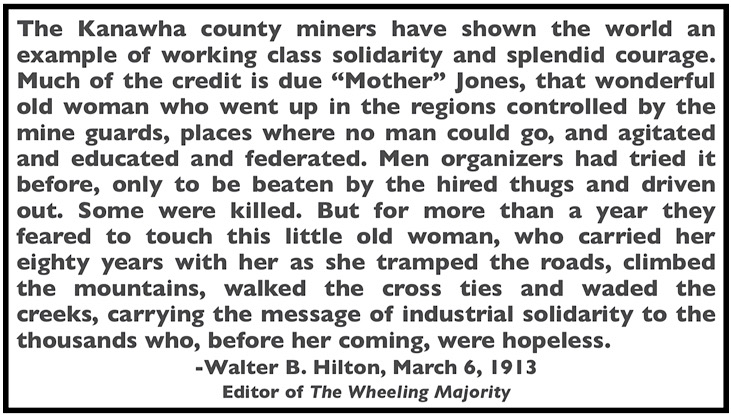 —————
—————
Hellraisers Journal – Sunday April 6, 1913
Kanawha County, West Virginia – Rights of West Virginians Must Be Restored
From The Wheeling Majority of April 3, 1913: